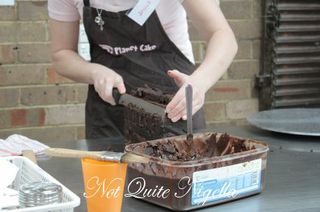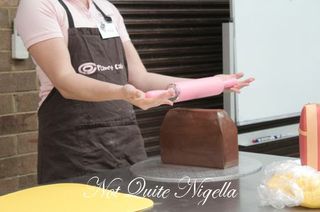
"Honey I hope you don't mind but your birthday cake is going to be a handbag" I told Mr NQN just before his recent birthday.
He looked at me, that usual skeptical look that he gives me when I suggest something that he isn't too thrilled about.
"But it will be blue!" I said gaily.
"What about that thousand layer apple cake instead?" he says cheekily.
"We don't talk about that cake any more" I told him firmly my mood turning instantly dark and I fix him with a menacing look_._

I was lucky enough to attend the Planet Cake Novelty 103 Complex Handbag Workshop recently. In fact it was the day before Mr NQN's birthday and I figured that having spent seven hours decorating a cake meant that I had no time to make another cake for him. Photographs are strictly not permitted at all Planet Cake cake decorating classes and our pre course email warns us that it can cause you to be ejected from the class without a refund. So I feel particularly lucky to be able to document this!

The class is being taught by Jessica, a cake artist and professional fighter (she sounds to me like a movie character "By day, she decorates cakes, by night she fights!" ). Marianne is the facilitator who ensures that we have all of our supplies. We all do introductions and I realise quite rapidly that I am out of my depth. You see I had missed that crucial word "complex" and I didn't realise that I had jumped a level in enrolling in this. Everyone else here is experienced in cake decorating so I shrink back and pray to the gods of pastry that a miracle will emerge. My bench neighbour Rebecca is here from interstate and has flown up for three classes. She will drive all the way back home with three cakes in the rental car. On my left is Veeni whose boyfriend is an NQN reader-hi!


We all start off which a 8x8 inch chocolate mud cake. For novelty cakes, a firm, dense cake like a mud cake is necessary as it needs to support decorations and also maintain the integrity of the structure. For that reason sponges and similar cakes are not used. She starts by slicing it into three layers horizontally. To do this, mark the layers using the back of a long, serrated knife and then moving the cake start cutting across. As it is a stainless steel knife, you simply watch the part of the knife that is closest to you and the top of the blade will follow.


To give it extra moisture brush it lightly with a sugar syrup (if you use a fruit infused one, make sure that the fruit pieces are strained out). Take your ganache filling. As it is Winter here in Australia at the moment, the ganache will set fairly hard quite quickly. So microwave the ganache on low heat until the corner of the container is soft and then whip it up incorporating some of the firmer but not hard areas of ganache to give yourself a fluffy ganache frosting that is also very spreadable.

Spread ganache on two of the layers and stick them together to put the cake together again. If your cutting isn't done smoothly they replace the layers in the same order much like a stacking puzzle (yes mine weren't!). We go back to our benches and do this for ourselves.



Then comes the part where I almost had a minor freakout. The cutting of the layers. Jessica warns us to always clean our serrated knife using the paring knife between cuts to avoid "dirty" cuts. She cuts it into just under a half and then cuts the second one into four pieces. She then stacks the pieces on top of each other until we reach a sort of rectangular tower shape. She places two pieces on the top. She then removes them and ganaches between them using a back and forth motion, never a patting motion as that is the quickest way to pick up crumbs. I suspect bricklayers would be very good at this part! We all go back and do this at our benches.




Once the ganache has set (10 minutes or so), the next part is the shaping. Jessica looks at the finished product (it always helps to have one as an example and a woman actually brought in her Kelly to model a cake on!) and compares and sees where it tapers in and marks it with a paring knife. All of the little gaps are filled with crumbs and the cut off pieces of cake which can be adhered with a tiny amount of ganache if needed although the mud cake is moist and will often stick together of its own accord. At the very base of the cake she slices into it giving it an indent where we will tuck the fondant under.

We then place some ganache on the presentation board and then adhere the cake onto it which by now looks like a house!




After this is done Jessica shows us how to ganache and buff the cake. This is important to ensure that the fondant has a completely smooth surface to rest on as any lumps can show through the fondant. The trick is to smooth the fondant on firmly with a palette knife and then use the metal smoothing tool to ensure that the finish is as smooth as possible.


Now comes the muscle bit. As I am short, I get a foot stool to help to incorporate the colouring gel into the fondant. I choose a blue and decide to have the bag all in the one finish, as a Louis Vuitton Speedy is all in one colour. I also want to make it in the Epi leather pattern so I will have to add the patterns on as soon as the fondant is added. After much exhaustion and a lot of kneading, my fondant is coloured (and we get to keep the fondant that we make, YAY!).

It's not quite the blue of the Epi but it will do as the darker colour that is needed, the harder it is to work with. She suggests avoiding red, blacks and browns as the colouring in those shades is so intense that it needs to rest overnight.

We then brush the cake with some sugar syrup ready for our fondant. We knead the fondant to soften it and then dust the table lightly with cornflour, place it presentation side up we roll it out into a rectangular shape making sure to turn it regularly to pick up the cornflour on the table. To measure the size of the fondant for the cake Jessica uses the rolling pin size as a guide. Sliding her hands and arms under the fondant, she gently blankets the cake with the fondant.



She creates two seams that sit at the back of the cake by folding it over. She then pats down the fondant onto the cake by using downwards motions and then cuts off the excess smoothing down the edges. Lastly she trims the edges of the icing flush against the cake. Then she buffs the cake using the acrylic smoothing tool. Airholes are removed with a fine pin on an angle. Marianne explains that sometimes airholes can grow even once lanced so it's important to keep an eye on them as they can stretch the fondant.



I manage to get my fondant on but not without a bit of drama. I didn't put it on properly so I had to remove it but by now there was some chocolate on the back of my fondant so I couldn't roll it again. Jessica explains that it's easy to deal with. Simply discard any pieces of fondant that have chocolate on them and then reroll it.


Using the thinnest side of the decorating tool I make stripes across the fondant filling in gaps while the fondant is still soft.

It then comes time to add on the base fondant, we roll out our white fondant and measure the size of our cakes leaving a couple of centimetres to allow for stretch. We slice out that size and carefully lift the white fondant over the cake itself and trim the edges to fit.



Now comes the fun bit-decorating the cake! We first measure the top dimensions of the cake to create the zipper. We use a ravioli cutter to make the actual zipper and then simulate the stitching using a stitching tool. We then cut four strips to make the side contrast panels. These are all adhered using a light brush of water. Jessica also shows us how to do a piping edge should we want to do that.





Now comes the tricky bit-the handle! I bet you were wondering like I was how on earth that happened like I was. Well the trick is flexible tubing and wooden dowel rods! Firstly measure the circumference on your plastic tubing by using a piece of fondant or tape measure. Then slice out a length with that width plus a little extra.


Stick your two dowel rods into each end of the tubing. Brushing some sticky piping gel onto the plastic tubing to ensure that the fondant sticks to it. Stick one dowel rod into some foam and wrap the fondant around the plastic tubing and then buff the edges together. Then we mark the places where we want to stick the handle and trim the dowel rods so that about 2 inches remains.


We then stick the handles into the cake finishing the job with tweezers or pliers as the fondant is still soft and cannot have pressure applied to it. They are then finished off with two squares of fondant that have stitching details on them.


The back handle is much easier. it is simply a sausage stuck on with water and two squares with stitching detail. I am pleased as it is finally starting to look like a bag! I look round and everyone's bags are different with different colours and different details and they all look magnificent.

The final fondant detail? The luggage tag of course. I was going to put Mr NQN's name on it but he is shy so I just put on NQN as Lorraine wouldn't have fit.


Everyone is busy finishing off their cakes. I then finish it off with some gold paint detail on the zipper and it is photo time! With cakes like this it's very tempting to keep going and going but viola, here is mine!



Although mine is a little wonky I am quite pleased that I managed to finish my cake. It's not quite as purty as the other's but I am amazed that it actually looks like a bag (well if you kind of squint ;) ).
So tell me Dear Reader, which novelty cake have you always wanted to know how to make?
NQN attended the Complex Handbag Cake decorating class as a guest of Planet Cake.
Planet Cake
106 Beattie Street, Balmain, NSW
Tel: +61 (02) 9810 3843
www.planetcake.com.au
The cost for the Complex Handbag class is $375 plus GST.



Reader Comments
Loading comments...Add Comment